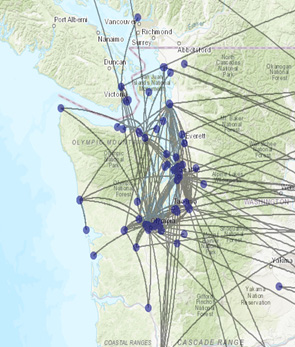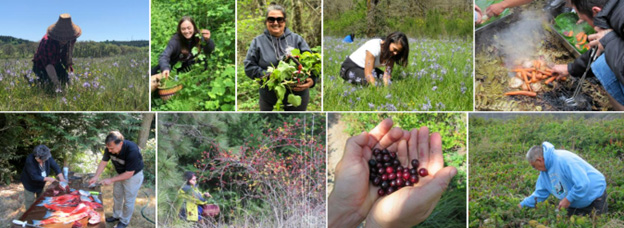“Transforming American Indian and Alaska Native STEM Learning via Indigenous Knowledge, Translation, Education, and the Environment” is a project centered around creating environmental education programs and curricula grounded in Indigenous knowledge and culture. Our team, including Feed Seven Generations, Garden Raised Urban Bounty (GRuB), Native Pathways, Oregon State University, Swinomish Indian Tribal Community, and the Urban Indian Health Institute, is developing the resources alongside regional community partners. The project is funded by the National Science Foundation (Grant Number: 1812543). Our resources promote community wellness in Indigenous communities and are designed to be adapted to meet the specific needs of each community. Indigenous communities have always passed down environmental knowledge, and the sharing of this knowledge has endured colonial regulation and erasure. This knowledge lives on through the networks and communities of Indigenous people and is still growing and changing today.
The way we evaluate our programs reflects Indigenous priorities and practices. We use methods grounded in cultural tradition and values to ensure that our programs are inclusive for the people who are participating. We honor our relationships to the communities with whom we work by integrating community feedback across all aspects of programming. We work together to share knowledge and feedback in ways that can help empower Indigenous communities and transform our programs to best serve participants.
 In 2020, project collaborators wanted to document and visualize the rich web of connections and support that has surfaced through implementation of our Indigenous environmental education programs and research. Social network analysis is a type of research that was originally developed to identify the cause of disease outbreaks in the early 20th century. A social network analysis helps researchers and community advocates better understand how relationships develop in a community, as well as the quality and types of relationships that are distributed across communities. Our social network analysis represents the ways that Indigenous communities share knowledge across geographies and generations. This is testimony to the strong relationships and commitments that have blossomed across Pacific Northwest Indigenous communities and beyond. Further, our analysis highlights the power of culturally based educational programs and health interventions. Individuals and organizations that utilize our programs contribute to our social network analysis through surveys, and primary partner organizations helped us to identify other key collaborators. The surveys and additional identification of collaborators helped us build a comprehensive view of who is involved and the reach of our educational networks.
In 2020, project collaborators wanted to document and visualize the rich web of connections and support that has surfaced through implementation of our Indigenous environmental education programs and research. Social network analysis is a type of research that was originally developed to identify the cause of disease outbreaks in the early 20th century. A social network analysis helps researchers and community advocates better understand how relationships develop in a community, as well as the quality and types of relationships that are distributed across communities. Our social network analysis represents the ways that Indigenous communities share knowledge across geographies and generations. This is testimony to the strong relationships and commitments that have blossomed across Pacific Northwest Indigenous communities and beyond. Further, our analysis highlights the power of culturally based educational programs and health interventions. Individuals and organizations that utilize our programs contribute to our social network analysis through surveys, and primary partner organizations helped us to identify other key collaborators. The surveys and additional identification of collaborators helped us build a comprehensive view of who is involved and the reach of our educational networks.
Western research methods often take a deficit-based approach to research and evaluation. This means that there is often a focus on challenges occurring within a community, like poverty, as opposed to community strengths such as informal economic support programs and community successes. In contrast, we intentionally focus on ways that Indigenous communities and our partners are resilient. We highlight how communities come together to revitalize and uplift Indigenous knowledge. We have infused the cultural and personal elements of our community research and education by building our network analysis around a story map. Story maps are visual online tools that help to give context to digital maps through photos, videos, and narrative text. Our story map is a visualization of the people, plants, places, and learning materials of our partners and program participants. Indigenous communities use storytelling as a traditional way to communicate knowledge and it continues to be an important form of traditional cultural education to this day. We recognize the power of stories to build and understand relationships in Indigenous communities and as such we designed our network analysis to capture stories of program participants. When opening the StoryMap, a learner can trace connections between organizations. They can read about the priorities of each organization, view photographs, and explore the connections between different partners in our work. Learners can also search for organizations using the Social Network Analysis tool.

The story map and network analysis are not solely designed for research and evaluation. We want our story map to empower communities, foster community dialogue, and highlight networks of support/belonging. Our story map helps connect Indigenous communities in their shared missions of revitalizing cultural practices, protecting the environment, and improving the health and well-being of Native Peoples and their descendants.
The story map website, which includes background information, videos, and highlights of member communities can be found here: ArcGIS StoryMap.
Our interactive network map can be found here: Social Network Map.
We developed our curricula with an emphasis on serving Native communities and so we focus on Indigenous knowledge, stories, and traditions. We have been careful to include only knowledge that is appropriate for a public audience and not knowledge that is privately held within families and communities. The curricula may also be applicable for non-Native educators and can be used as a model for other regions. If you or your organization would like to learn more about our programs or about resources for Indigenous environmental health, please visit our program website at nativeplantsandfoodsportal.org.